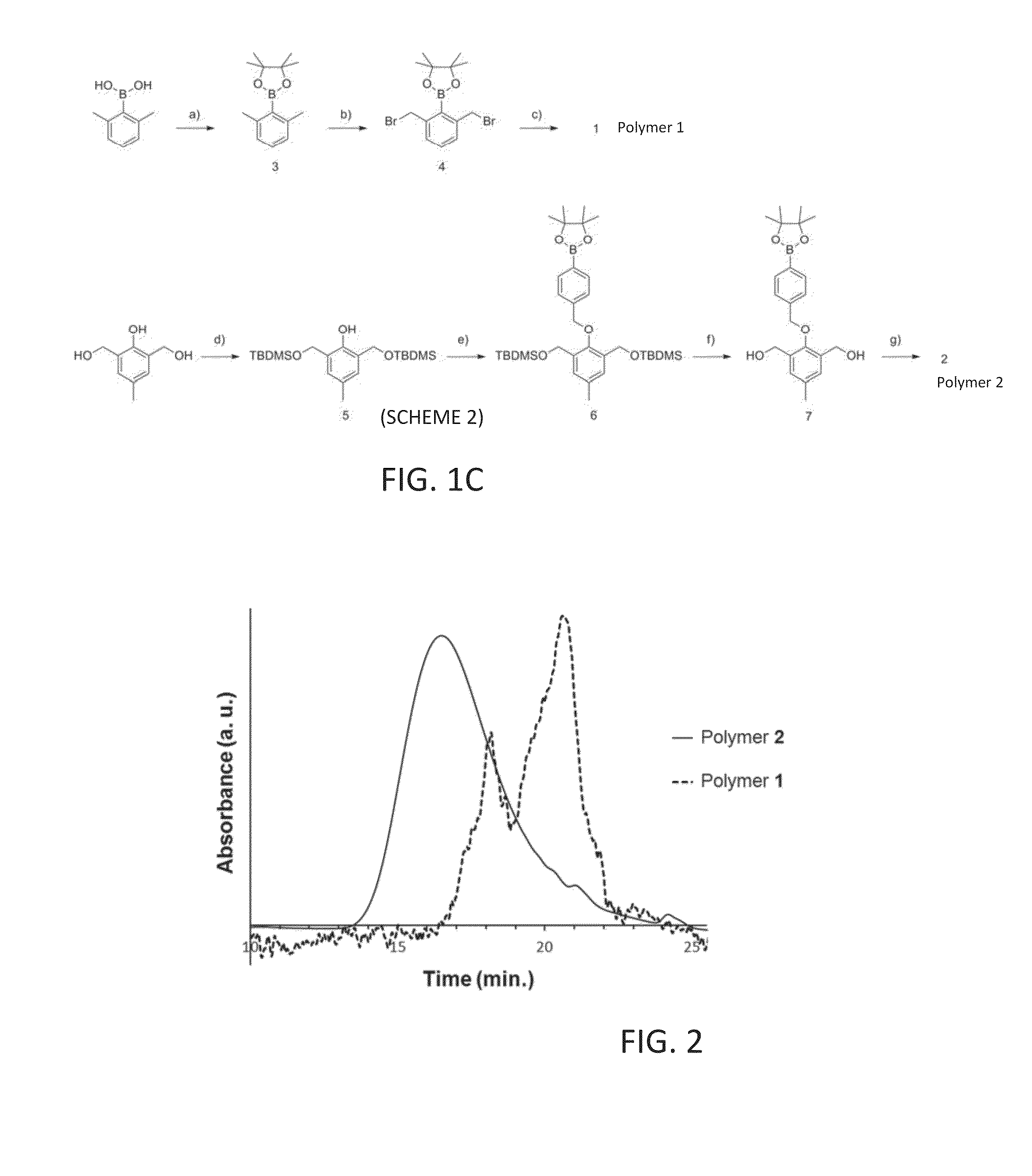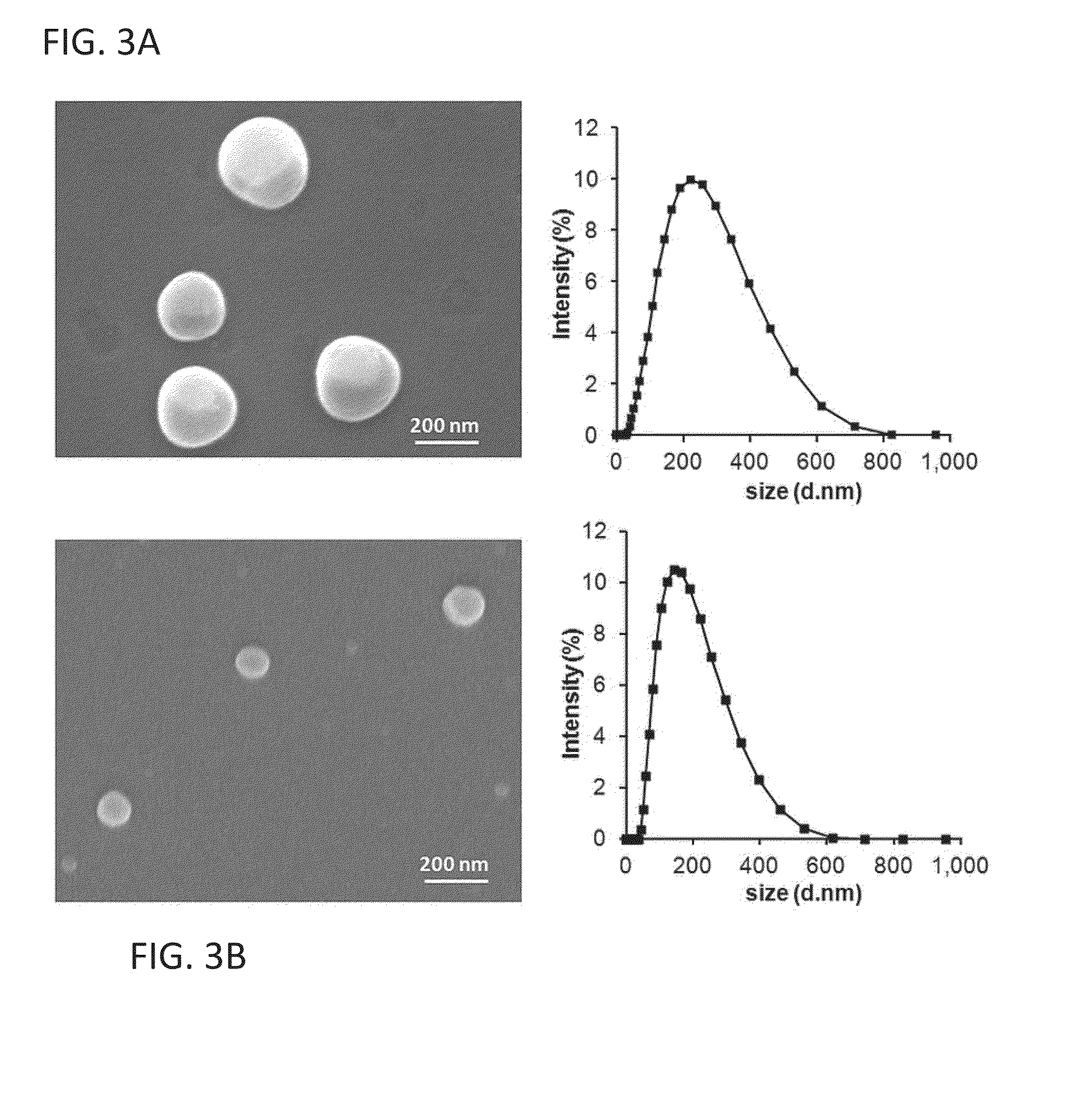Biocompatible polymeric nanoparticles degrade and release cargo in response to biologically relevant levels of hydrogen peroxide
a biocompatible, nanoparticle technology, applied in the field of nanoparticles, can solve the problems of ros such as superoxide, hydrogen peroxide, hydroxide radical damage to cellular components, and the current polymeric system is not sensitive to biological relevance, and achieves the effect of selective anti-inflammatory delivery
- Summary
- Abstract
- Description
- Claims
- Application Information
AI Technical Summary
Benefits of technology
Problems solved by technology
Method used
Image
Examples
example 1
Synthesis of Compound 3, Scheme 2 (FIG. 1C)
[0124]2,6-dimethylphenylboronic acid (2.5 g, 16.67 mmol) and pinacol (2.36 g, 20.0 mmol) were added to a round bottom flask. The solids were dissolved in benzene (66.67 mL). A Dean-Stark apparatus / distilling receiver was attached to the flask and filled with benzene. A water cooled condenser was attached to the Dean-Stark apparatus. The reaction was heated to a vigorous reflux and stirred overnight.
[0125]Afterwards, the reaction was removed from heat allowed to cool to room temperature. Then, the solution was concentrated under reduced pressure, taken up in a minimal volume of benzene, and purified with a silica gel column using EtOAc / Hexanes. Concentration of selected fractions under reduced pressure afforded the product as a colorless oil (3.24 g, 84%).
[0126]1H NMR (CDCl3): δ 7.12 (t, J=8.0 Hz, 1H), 6.95 (d, J=8.0 Hz, 2H), 2.40 (s, 6H), 1.40 (s, 12H). 13C CDCl3): δ 141.6, 129.1, 126.4, 83.4, 24.9, 22.1. ESI-MS (+): m / z calc. for C14H21BO2...
example 2
Synthesis of Compound 4, Scheme 2 (FIG. 1C)
[0127]To a round bottom flask, boronic ester 3 (1.6 g, 6.9 mmol), AIBN (0.1, 0.7 mmol), and NBS (2.6 g, 14.4 mmol) were added. Carbon tetrachloride was added to the flask. The reaction was refluxed and stirred overnight. Afterwards, the suspension was filtered and the filtrate was concentrated under reduced pressure. The solid was dissolved in a mixture of CH2Cl2, acetone, and EtOAc.
[0128]The resulting solution was purified on silica gel using EtOAc / Hexanes. Selected fractions were concentrated to give a white solid (2.36 g, 88%). To achieve higher purity, the white solid was recrystallized in a minimal volume of hot i-PrOH or in a mixture of hexane and ethylacetate (1.48 g, 55%).
[0129]1H NMR (CDCl3): δ 7.29 (m, 3H), 4.82 (s, 4H), 1.47 (s, 12H). 13C CDCl3): δ 144.3, 130.6, 130.0, 84.4, 34.1, 25.3. ESI-MS (+): m / z calc. for C14H19BBr2O2: 387.98; found: 407.96 [M+NH4]+, 412.94 [M+Na]+. High resolution ESI-TOF MS, m / z (M+) calcd. 408.0163, fou...
example 3
Synthesis of Polymer 1, Scheme 2 (FIG. 1C)
[0130]Tetrabutylammonium hydroxide, 40% in H2O, (2.9 mL) was added to a reaction vessel containing adipic acid (238.2 mg, 1.6 mmol). The solution was heated to 62° C. till a homogeneous solution was formed. A chloroform (6.2 mL) solution of benzyl bromide 3 (952.8 mg, 2.4 mmol) was added. The reaction was heated at 62° C. overnight.
[0131]The solution was then partitioned between H2O and CH2Cl2 and extracted with 2 portions of CH2Cl2. The organic layers were combined and washed with brine, dried over Na2SO4, and filtered. The filtrate was concentrated. The solid was taken up in methanol and partitioned with H2O. The solution was extracted with 2 portions of EtOAc. The combined organic layers were washed with brine, dried over Na2SO4, filtered, and concentrated.
[0132]The obtained white solid (770 mg) was purified by gel filtration using Sephadex G10 in DMF. This allowed the separation of the target polymer from salts, smallest oligomers, unrea...
PUM
| Property | Measurement | Unit |
|---|---|---|
| Molar density | aaaaa | aaaaa |
| Atomic weight | aaaaa | aaaaa |
| Atomic weight | aaaaa | aaaaa |
Abstract
Description
Claims
Application Information
 Login to View More
Login to View More - R&D
- Intellectual Property
- Life Sciences
- Materials
- Tech Scout
- Unparalleled Data Quality
- Higher Quality Content
- 60% Fewer Hallucinations
Browse by: Latest US Patents, China's latest patents, Technical Efficacy Thesaurus, Application Domain, Technology Topic, Popular Technical Reports.
© 2025 PatSnap. All rights reserved.Legal|Privacy policy|Modern Slavery Act Transparency Statement|Sitemap|About US| Contact US: help@patsnap.com



